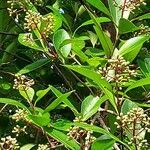Shrubs or small trees, evergreen, to 10(-15) m tall. Bark gray-brownish. Branchlets of current year green or reddish, glabrous or sometimes sparsely yellow-brownish stellate-pubescent; branchlets of previous year gray or gray-brownish, terete, glabrous, with dispersed, small, raised lenticels. Winter buds ovoid-lanceolate, with 2-4 pairs of separate scales; scales glabrous. Leaves always opposite, not clustered at apices of branchlets; stipules absent; petiole green or reddish, robust, 1-2(-3) cm, glabrous or stellate-pubescent; leaf blade green when young, becoming intense green and lustrous adaxially, elliptic to oblong or oblong-obovate to obovate, sometimes suborbicular, 7-20 × (3-)4-9 cm, leathery, abaxially sometimes with sparse, dispersed dark red minute glands, both surfaces glabrous or sparsely stellate-pubescent on veins, midvein raised and conspicuous abaxially, lateral veins 4-9-jugate, pinnate, arched, branched, anastomosing near margin, conspicuously raised abaxially, slightly impressed adaxially, veinlets transverse, slightly raised abaxially, inconspicuous adaxially, not lobed, base broadly cuneate, rarely rounded, without glands, margin irregularly serrate except at base or subentire, apex shortly acute to obtusely acute and mucronate, sometimes obtuse or subrounded. Flowers appearing after leaves; inflorescence paniculate, pyramidal, terminal or at apices of short lateral branchlets with 1-jugate leaves, (3.5-)6-13.5 × (3-)4.5-6 cm; rays opposite, decussate; first node of inflorescence with 2 rays, lax, large, glabrous or stellate-pubescent, without large sterile radiant flowers; peduncles 4-10 cm; bracts caducous, leaflike, greenish, less than 1 cm × 2 mm, lanceolate to ovate, sparsely hairy; bracteoles scalelike. Flowers usually on rays of 2nd and 3rd orders, fragrant, sessile or shortly pedicellate. Calyx green; tube tubular-campanulate, 1.5-4 mm, glabrous; lobes broadly triangular, ca. 1 mm, glabrous, apex obtuse. Corolla white, later yellow-whitish, sometimes reddish, rotate, ca. 7 mm in diam., glabrous; tube ca. 2 mm; lobes reflexed, orbicular-ovate, 2-3 mm, apex rounded, margin entire. Stamens slightly exceeding corolla lobes, inserted at apex of corolla tube; filaments 2.5-3 mm; anthers yellow, oblong, nearly 2 mm. Styles not exceeding calyx lobes; stigmas capitate or slightly 3-lobed. Fruit initially turning red, maturing nigrescent, ovoid or ovoid-ellipsoid, ca. 8 × 5-6 mm, base rounded, apex rounded, glabrous; pyrenes compressed, ovoid or ovoid-ellipsoid, ca. 7 × 4 mm, with a deep ventral groove, apex rounded. Fl. Mar-May, fr. Jun-Sep. 2n = 40.
More
Shrub or small tree, sometimes up to 20 m, glabrous, only youngest parts with few stellate hairs. Leaves more or less coriaceous, dull or somewhat shining, glabrous or underside with few scattered stellate hairs and somewhat bearded in the nerve-axils, elliptic-oblong to oblong-lanceolate or obovate, 8-15 by 3-7 cm, apex shortly and bluntly acuminate, rarely rounded or emarginate, base attenuate, margins in the upper half obsole-tely (sometimes distinctly) toothed or nearly entire, cartilagineous; nervation prominent beneath; primary nerves 5-7 on each side, indistinctly anastomosing; petioles (½-)1-2 cm. Inflorescence paniculate, more or less elongated pyramidal, up to 10 cm long and wide, many-flowered; axes slightly stellate-pubescent; peduncle 2-5 cm, primary branches verticillate, divaricate; bracteoles linear-lanceolate, ciliate, 1-3 mm long. Flowers fragrant, 5-6 mm wide. Calyx-limb cupular, 1 mm long, teeth broad-triangular, glabrous or sparsely ciliate. Corolla obovoid to ellipsoid-obovoid in bud, shortly funnel-shaped-campanulate when open, creamy white, glabrous or sometimes with some stellate hairs on outside, tube gradually widened upwards, 2-3 mm, limb horizontally spreading, finally reflexed, lobes broad-ovate, rounded, somewhat overlapping, 2 mm. Stamens exserted, filaments adnate to corolla-throat, in bud with inflexed top, 2-3 mm; anthers oblong, 1½-1¾ mm. Ovary glabrous, 1½-2 mm long. Drupe ovoid, 6-7 by 4-5 mm, purplish-black. Endocarp dorsiventrally compressed and strongly incurved, edges nearly touching, ventral side strongly concave, embracing a cavity of 1½-2 mm diam. Seed strongly compressed, falcate in cross-section, 1 mm thick.
A large evergreen shrub. It grows 4 m high and spreads 2 m across. The stem is erect and branching. The leaves are glossy green, oval and thick. The flowers are in broad cone shaped arrangements. They are small, white and have a scent. The fruit are red berries which turn black when ripe.


